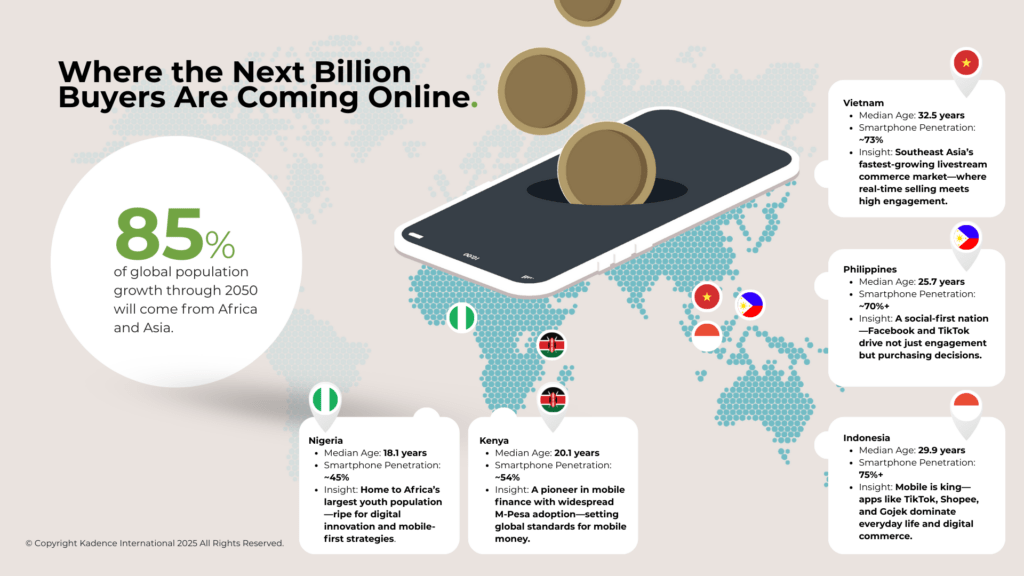Late one evening in Lagos, 22-year-old Chika is scrolling through TikTok, eyes fixed on a local influencer demoing the latest face serum. She watches the 30-second video twice, screenshots the product, and toggles over to Jumia to compare prices, scanning reviews that look a little too polished to be real. Before checking out, she sends a message to her cousin in Ibadan: “Have you tried this one? Is it legit?” Only after a thumbs-up and a money-back assurance from the seller does she complete the purchase – on mobile, of course.
This isn’t an isolated case. It’s a snapshot of how the next billion consumers will shop, click, and connect.
While Western economies grapple with saturation, inflation, and shifting loyalty, the momentum is migrating – toward Southeast Asia, Africa, and parts of Latin America. These regions are no longer just “emerging markets.” They are where the most dynamic, mobile-first, and digitally sophisticated consumers are coming of age.
The numbers make the case undeniable. According to the United Nations, over 85% of global population growth through 2050 will come from Africa and Asia. The GSMA reports that mobile internet penetration in Sub-Saharan Africa is set to reach 50% by 2025, up from 28% in 2019. Meanwhile, the World Bank highlights how smartphone adoption is leapfrogging traditional infrastructure, giving rise to an entire generation that skipped the PC era entirely.
But these consumers are not easily won. They are bilingual and bicultural, equally fluent in local slang and global memes. They are digitally native but deeply mistrustful, having grown up in online ecosystems rife with scams, misinformation, and empty brand promises. And they are forcing brands – both global and local – to rethink what it means to earn attention, deliver relevance, and build trust in the age of hyper-connectivity.
This is not just a demographic shift. It’s a behavioral revolution. And it’s already underway.
Meet the Next Billion: Demographics, Access, and Expectations
This new wave of consumers is young, connected, and coming online fast. In markets like Nigeria, Indonesia, Vietnam, and the Philippines, the median age hovers around 25. These are societies where more than half the population wasn’t yet born when Facebook launched – and for them, digital engagement isn’t an evolution; it’s a native state.
Urbanization is accelerating across these regions, but it’s not confined to megacities. Second- and third-tier cities are becoming powerful engines of growth, fueled by digital access and rising educational attainment. In Vietnam, for instance, over 94% of youth are literate, and the number of university graduates has doubled over the past decade. Similarly, Nigeria’s youth enrollment in tertiary education is climbing, despite infrastructure constraints. With education comes language dexterity: millions speak at least two languages – one local, one global – and they switch between them instinctively, depending on the context, platform, or audience.
If their predecessors logged onto the internet, this generation lives inside it – and does so almost exclusively via smartphone. In Indonesia, smartphone penetration has surpassed 75%, with apps like Tokopedia, Gojek, and Shopee becoming gateways to everything from groceries to financial services. In sub-Saharan Africa, handset affordability and prepaid data plans have made mobile the default medium for learning, shopping, and socializing. The desktop? Many have never touched one.
Browser-based experiences are increasingly irrelevant. Instead, this generation navigates a constellation of apps, each with its own cultural role. WhatsApp is for family, Instagram for aspiration, TikTok for entertainment, and Telegram or local forums for unfiltered information. Platform behavior is deeply segmented and purpose-driven. Brands attempting to force a uniform message across channels are quickly tuned out.
And while their tech habits may look similar from a distance, the nuances run deep. In Nigeria, digital spaces are often leveraged as tools for activism and community solidarity. Mistrust in institutions has made peer recommendations and online reputation more powerful than formal brand campaigns. By contrast, in Indonesia, religious and cultural values shape how products are perceived and promoted – especially in sectors like fashion, beauty, and food. Vietnamese consumers, on the other hand, exhibit a high degree of tech optimism, embracing e-wallets and livestream commerce, but place enormous emphasis on product quality and after-sales service, driven by prior experiences with low-cost imports.
These differences matter. What unites the next billion is their digital fluency, but what distinguishes them is the lens through which they evaluate brands. A price drop may trigger interest in Nigeria, but in Vietnam, durability and performance often take precedence. In Indonesia, localized design or halal certification may be the tipping point. The common thread is that these consumers are not passive recipients of global marketing – they are active participants, savvy navigators, and, increasingly, vocal critics.
To engage them, brands must move past old assumptions about emerging markets being homogenous or easily won with scale. What’s unfolding is a more complex, more nuanced, and more demanding consumer environment – and it’s being shaped not just by demographics, but by deep-seated expectations forged in mobile-first, culturally hybrid, and rapidly evolving societies.

Mistrust Is the Default Setting
For many of the next billion consumers, skepticism isn’t a reaction – it’s a reflex. Decades of unreliable infrastructure, political instability, and inconsistent enforcement of consumer rights have conditioned buyers to approach brands and platforms with guarded caution. In these markets, trust is not assumed; it’s earned slowly and lost quickly.
The scale of the challenge is significant. According to Edelman’s 2024 Trust Barometer, trust in institutions – including businesses – remains markedly lower in developing regions than in developed ones. In Nigeria, only 42% of respondents said they trust brands “to do what is right,” compared to 62% in the UK. In Indonesia, that figure was closer to 50%, but even there, trust is often linked to familiarity rather than formal reputation – people tend to trust people, not corporations.
This backdrop has fueled the rise of peer-to-peer influence as a dominant decision-making force. In the Philippines, Facebook community groups like “Online Budol Finds” (slang for impulsive purchases) function as real-time marketplaces and review boards, where users share unfiltered opinions about products, pricing, and service. In Kenya, WhatsApp groups play a similar role, serving as both watchdog and validator in a system where traditional consumer protections are weak or absent. Even in Vietnam, where e-commerce infrastructure has rapidly improved, 54% of online shoppers say they rely on recommendations from friends or family over brand messaging, according to Statista.
This preference for informal verification mechanisms stems from bitter experience. Counterfeit goods remain a rampant issue across markets – from fake electronics in Ghana to diluted skincare products in Indonesia. In response, many consumers have developed an internal checklist: check the seller’s social proof, confirm the payment method, look for real customer images, and verify delivery policies. Brands that fail even one of these checks are likely to be discarded in seconds.
At the same time, digital mistrust is compounding the issue. Scams, phishing attacks, and fake reviews have tainted the e-commerce experience. The GSMA estimates that more than 40% of mobile internet users in Africa and Southeast Asia have experienced some form of online fraud or misleading advertising. In Indonesia alone, the National Cyber and Crypto Agency reported over 190 million cyberattacks and suspicious traffic incidents in 2023.
In this climate, even influencer marketing – a strategy once thought to fast-track trust – has grown less effective. In Vietnam, consumers increasingly question whether influencers are being paid to promote products they don’t actually use. The same holds true in Nigeria, where audiences are savvy enough to distinguish between genuine recommendations and sponsored scripts. The result is a gradual shift toward micro-influencers and community advocates, whose endorsements feel more relatable and less rehearsed.
The implications for global brands are profound. Standard top-down marketing no longer carries weight. Instead, trust must be layered in – through reliable service, consistent messaging, transparency in returns and refunds, and responsiveness on the platforms where consumers are active. Brands must also recognize the importance of publicly visible customer interactions. A fast, empathetic reply to a complaint in the comments section may matter more than a million-dollar ad campaign.
Trust, in this context, is not a brand asset; it’s a user experience outcome. And in a market where every interaction becomes a review, the next billion are watching, judging, and sharing – with or without you.
The Battle for the First Page (or First Screen)
For the next billion consumers, the path to purchase doesn’t begin with a browser search – it starts with a scroll. Discovery has shifted from keywords to content, from desktop search bars to full-screen video, and from global search engines to localized social ecosystems. As a result, the first screen – what shows up in a feed, on a homepage, or in a chat group – has become the most valuable real estate in the customer journey.
In Indonesia, 71% of internet users aged 16–24 say they use social media as their primary source for researching brands, according to DataReportal 2024. In Nigeria, that figure is nearly identical. TikTok, Instagram Reels, Facebook Marketplace, and YouTube Shorts aren’t just distractions – they’re digital storefronts where decisions are made in real time, often before a brand’s official website is ever visited. The lines between content, commerce, and community have all but vanished.
And while this trend is visible globally, its intensity in emerging markets is distinct. A key reason: data affordability drives platform choice and usage behavior. Telecom bundles that include free access to Facebook or WhatsApp often influence which platforms dominate attention. In the Philippines, for example, “Free FB” packages have made Facebook one of the most deeply entrenched platforms in the country’s digital culture – so much so that some users mistakenly believe it is the internet.
The importance of platform-specific strategy can’t be overstated. In Vietnam, product discovery frequently occurs through livestream commerce on TikTok Shop, where real-time interactions foster a sense of authenticity. In Kenya, small businesses routinely post promotions through WhatsApp Status or Telegram channels, bypassing traditional ad formats altogether. In Nigeria, where Twitter (now X) has a strong political and cultural presence, product conversations often unfold in threads filled with memes, humor, and direct audience engagement.
But it’s not just about where brands show up – it’s about how they’re experienced in the moment. Load speed, image optimization, and mobile UX have a direct impact on trust and retention. According to Google, 53% of mobile users in emerging markets will abandon a page that takes longer than three seconds to load. And that’s not just about tech – it’s about expectations. These consumers are used to fast, seamless, and low-friction digital experiences. Anything less suggests the brand doesn’t understand them.
Just as critically, language and localization now serve as first impressions. A landing page that defaults to English – or worse, uses awkward machine translations – can signal cultural detachment. By contrast, content tailored in local languages, with region-specific slang and visual references, is seen as a mark of respect and investment. It says: we’re not just here to sell; we’re here to understand.
In a space where attention is both fleeting and fiercely fought over, success no longer goes to the loudest voice or biggest budget. It goes to the most culturally fluent, visually intuitive, and platform-native presence. Winning the first screen isn’t about visibility alone – it’s about resonance.
The Rise of Reverse Aspiration and Quiet Power
Western brands once assumed that success in emerging markets meant becoming aspirational – symbols of modernity and affluence. But for today’s mobile-first generation, the tables are turning. Increasingly, it is not global prestige that earns admiration, but local relevance. In place of overt aspiration, there’s a growing sense of pride in indigenous culture, self-made success, and digital independence. What’s emerging is a quiet power: consumers who no longer seek to imitate the West, but expect brands – foreign and domestic – to meet them on their terms.
Across Southeast Asia and Africa, there’s a perceptible shift from status to substance. In Nigeria, youth are driving a surge in support for homegrown fashion labels like Orange Culture and Ashluxe – brands that blend global aesthetics with distinctly African narratives. A 2023 Euromonitor report found that 64% of Nigerian Gen Z consumers said they prefer to buy local brands that reflect their identity, even when international options are available.
This isn’t limited to apparel. In Indonesia, the halal cosmetics market has seen explosive growth, not merely as a religious preference but as an expression of cultural values. Brands like Wardah and Emina now rival – or outperform – multinational competitors in brand recognition among young women. These brands don’t compete by mimicking Western tropes. They succeed by embedding themselves in the rhythms of local life, from religious observances to beauty standards shaped by regional influencers rather than global celebrities.
The same dynamic is playing out in Vietnam’s tech sector, where local e-wallets like MoMo are outpacing foreign fintech entrants – not because of superior technology, but because they better understand the daily behaviors, payment rituals, and security concerns of the Vietnamese consumer. According to a 2023 study by Decision Lab, MoMo enjoys over 60% brand preference among young urbanites, in part due to its partnerships with local merchants and integration into everyday routines like topping up phone credit or paying utility bills.
Meanwhile, global culture is increasingly being shaped by these same markets. Afrobeats, once a niche genre, now tops international charts. Thai skincare routines are influencing global beauty trends. Filipino content creators are gaining global followers on TikTok not because they adapt to global norms, but because they confidently showcase their own. In this way, reverse aspiration is not just a rejection of old hierarchies – it’s an export of influence.
For brands, the lesson is clear: you are not the center of the story. Consumers no longer measure themselves against your brand identity. Instead, they measure your brand against their values, communities, and cultural fluency. Products must be flexible, not fixed; branding must adapt, not dictate.
The rise of reverse aspiration doesn’t signal hostility toward global brands – it signals maturity. These consumers aren’t trying to join the global mainstream. They are the mainstream – digitally savvy, culturally proud, and shaping the conversation on their own terms. And they expect brands to understand that before making their pitch.
Strategies to Earn Attention and Trust
Capturing the attention of the next billion is not a matter of flashy creative or inflated ad budgets. These consumers are deliberate and discerning, quick to disengage from brands that don’t meet their standards or speak their language – both literally and figuratively. Trust is not a funnel; it’s a framework. And it requires consistent, intentional action across every touchpoint.
1. Hyper-localization isn’t optional – it’s foundational.
For emerging market consumers, brand credibility is tightly linked to cultural fluency. It goes beyond simple translation to a full embrace of local values, references, and usage contexts. In Vietnam, the delivery app Baemin differentiated itself by infusing its platform with witty Vietnamese slang, inside jokes, and hyper-specific product categories – earning loyalty not through function, but through cultural intimacy. In Kenya, Safaricom’s M-Pesa succeeded not just as a mobile payments tool, but because it was built around the realities of an unbanked population, with offline integration and SMS functionality that anticipated connectivity challenges.
2. Trust is built in the micro-moments.
In high-trust economies, consumers might forgive a misstep. In low-trust markets, every interaction matters. A delayed delivery, a missing refund, or a slow response to a query can permanently damage perception. In Indonesia, beauty brand Sociolla won favor by offering guaranteed authentic products, tracked delivery, and a no-hassle return policy – features that directly addressed consumer anxieties in a market flooded with counterfeits. Transparency, speed, and customer service are not operational choices; they are brand positioning strategies.
3. Community voices trump corporate messaging.
The age of the polished brand ambassador is fading. Peer influence, especially from micro-influencers and everyday content creators, now holds more sway. These are people with modest followings but high engagement, often speaking in native dialects or regional slang. In the Philippines, Shopee’s partnership with grassroots creators in smaller cities – rather than national celebrities – helped drive adoption among new internet users. Brands that co-create with local voices, elevate real customer stories, and share behind-the-scenes content signal a level of openness that consumers find relatable and reassuring.
4. Simplification drives conversion.
The mobile-first mindset means consumers expect streamlined interfaces, fast-loading pages, and frictionless payment processes. The most successful brands eliminate barriers rather than adding features. In India, Meesho – a platform that allows users to resell products through WhatsApp and Facebook – gained explosive traction not by competing on price or product, but by simplifying commerce to match the rhythms of informal entrepreneurship. Especially in markets with lower digital literacy or inconsistent connectivity, simplicity is not just convenient – it’s empowering.
5. Offer real value, not just marketing.
Beyond product benefits, brands that offer utility, knowledge, or community are more likely to earn sustained engagement. During the pandemic, Vietnam’s Vinamilk launched a nutrition education series across Facebook Live, fronted by local pediatricians and nutritionists. The effort was not overtly commercial, but it positioned the brand as a trusted source in a time of uncertainty – building long-term brand equity. Similarly, in Africa, MTN’s “Y’ello Hope” campaign provided remote learning support and free data for health workers, deepening brand connection far beyond mobile service.
6. Show up where it matters – and stay.
Too often, international brands treat emerging markets as seasonal experiments, testing campaigns without long-term investment. But consistency is critical. Consumers notice who’s around during key holidays, national events, and crises – and who disappears when results don’t come quickly. Building trust means being present, listening actively, and responding quickly, even when it’s not convenient. It means moving from transactional to relational.
Attention and trust are hard-won in these markets – but not impossible. Brands that succeed will be those that listen before speaking, localize without diluting, and deliver value at every step. It’s not about cracking a code – it’s about showing up, with respect, relevance, and reliability.
What the Next Billion Means for Global Strategy
The next billion consumers will not just change where companies grow – they will fundamentally reshape how companies think. For too long, emerging markets have been treated as the final frontier for global brands – places to extend reach and scale after success was achieved elsewhere. That model is not only outdated; it’s strategically short-sighted.
In markets like Vietnam, Kenya, and the Philippines, consumer expectations are being forged under entirely different conditions: mobile-first access, economic volatility, rapid urbanization, and a deep mistrust of centralized systems. The result is a set of behaviors that are more adaptive, more skeptical, and often more innovative than those seen in mature markets. Consumers here are not merely catching up – they are setting new standards.
Rather than viewing these markets as extensions of Western playbooks, companies should see them as innovation testbeds. Take mobile commerce: features like embedded payments, one-click checkout via messaging apps, or app-free transactions are not novelties – they are necessities driven by constraints around bandwidth, infrastructure, and financial inclusion. Yet these same constraints are producing solutions that may become best practices globally.
Similarly, platform design in these regions often centers on immediacy, low data consumption, and local integration. Global teams should be asking: What can we learn from the success of super apps in Southeast Asia? From the rise of voice notes and vernacular language content in India? From trust mechanics built into informal commerce networks across West Africa? These are not fringe behaviors – they are indicators of where global user expectations are headed.
The ability to operate in these ecosystems requires more than translation. It demands cultural intelligence, operational flexibility, and a long-term mindset. Localization must move beyond interface tweaks to encompass everything from payment methods and logistics to influencer partnerships and community engagement. A product launch is no longer the finish line; it’s the beginning of a multi-year trust-building process.
This shift calls for investment – not just in marketing – but in on-the-ground research, in building local teams with decision-making power, and in systems that can adapt quickly to feedback loops. The brands that will thrive are those that listen early, prototype fast, and refine continuously. That’s not reactive – it’s resilient.
The next billion are not waiting to be discovered. They are already online, already informed, already choosing. But they are choosing carefully. Their loyalty isn’t earned by reputation – it’s earned by repetition: consistent delivery, relevance, and respect over time.
What we’re seeing isn’t a short-term trend – it’s a structural redefinition of what global success looks like. And in this new equation, the old formulas – centralized control, broad generalizations, and push marketing – no longer hold. The competitive edge will belong to those who approach these markets not as territories to conquer, but as partners in evolution.
Because when consumers are multilingual, mobile-first, and mistrustful by design, brand engagement becomes a privilege – not a right. The challenge is not whether companies can reach them. It’s whether they can rise to meet them.
Get regular insights
Keep up to date with the latest insights from our research as well as all our company news in our free monthly newsletter.





 Senior Marketing Executive
Senior Marketing Executive Sales & Marketing
Sales & Marketing General Manager PR -Internal Communications & Government Affairs
General Manager PR -Internal Communications & Government Affairs Vital Strategies
Vital Strategies
 Customer Intelligence Director
Customer Intelligence Director